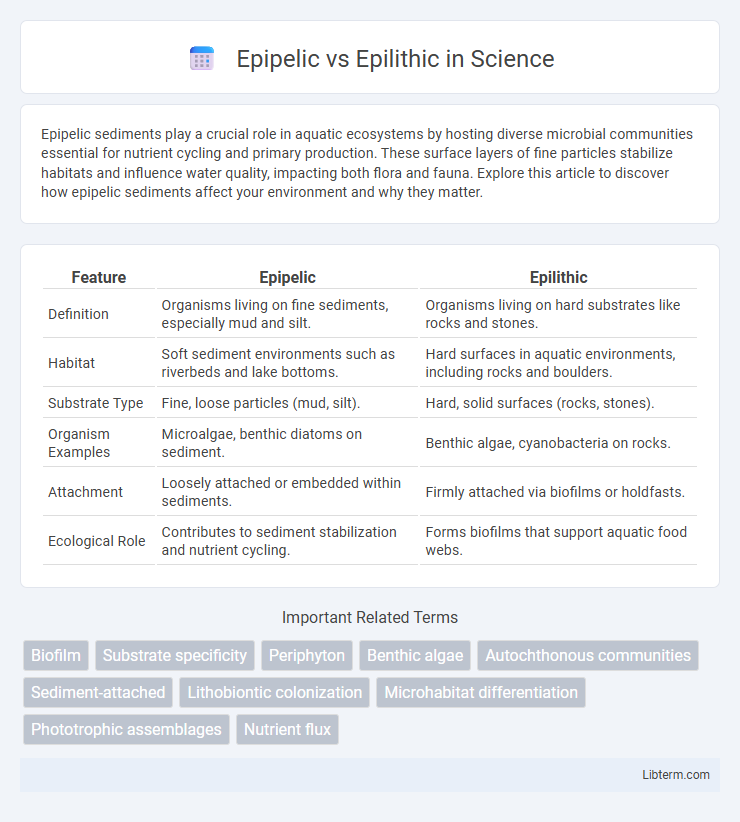Epipelic sediments play a crucial role in aquatic ecosystems by hosting diverse microbial communities essential for nutrient cycling and primary production. These surface layers of fine particles stabilize habitats and influence water quality, impacting both flora and fauna. Explore this article to discover how epipelic sediments affect your environment and why they matter.
Table of Comparison
| Feature | Epipelic | Epilithic |
|---|---|---|
| Definition | Organisms living on fine sediments, especially mud and silt. | Organisms living on hard substrates like rocks and stones. |
| Habitat | Soft sediment environments such as riverbeds and lake bottoms. | Hard surfaces in aquatic environments, including rocks and boulders. |
| Substrate Type | Fine, loose particles (mud, silt). | Hard, solid surfaces (rocks, stones). |
| Organism Examples | Microalgae, benthic diatoms on sediment. | Benthic algae, cyanobacteria on rocks. |
| Attachment | Loosely attached or embedded within sediments. | Firmly attached via biofilms or holdfasts. |
| Ecological Role | Contributes to sediment stabilization and nutrient cycling. | Forms biofilms that support aquatic food webs. |
Introduction to Epipelic and Epilithic Communities
Epipelic communities consist of microalgae and microorganisms inhabiting fine sediments like mud and silt in aquatic environments, playing a crucial role in nutrient cycling and sediment stability. Epilithic communities, by contrast, colonize hard substrates such as rocks and stones, adapting to fluctuating water flows and exposure conditions. Both communities contribute to ecosystem productivity but differ fundamentally in substrate preference and ecological function.
Defining Epipelic Organisms
Epipelic organisms are microorganisms that inhabit fine sediments, such as mud or silt, in aquatic environments, where they move actively within the sediment matrix. These organisms differ from epilithic organisms, which colonize hard substrates like rocks and stones, forming biofilms on their surfaces. The defining characteristic of epipelic organisms is their motility and association with soft, unconsolidated sediments, allowing them to exploit nutrient-rich microhabitats unavailable to sessile epilithic species.
Understanding Epilithic Organisms
Epilithic organisms are microbial communities, primarily algae and bacteria, that colonize the surfaces of rocks and stones in aquatic environments, playing a vital role in biofilm formation and nutrient cycling. These organisms adhere firmly to hard substrates, contributing to habitat stability and serving as a crucial food source for invertebrates and other aquatic life. Understanding epilithic organisms involves studying their adaptive mechanisms for attachment, resistance to shear stress, and their ecological impact compared to epipelic organisms, which inhabit sediment surfaces.
Key Differences Between Epipelic and Epilithic
Epipelic organisms live on or within fine, loose sediments like mud or silt, while epilithic organisms attach to hard surfaces such as rocks or stones. Epipelic communities are adapted to dynamic environments with soft substrates, facilitating motility and sediment interaction, whereas epilithic communities thrive on stable, solid substrates providing firm attachment points. The key difference lies in their substrate preference and associated ecological adaptations influencing their distribution and functional roles in aquatic ecosystems.
Habitat Preferences and Distribution
Epipelic algae predominantly inhabit soft substrates such as mud and fine sediments in freshwater and marine environments, thriving in nutrient-rich conditions with low water flow. In contrast, epilithic algae colonize hard surfaces like rocks and pebbles, often found in fast-flowing streams and tidal zones where light exposure is high. Distribution patterns reflect these habitat preferences, with epipelic species commonly dominating estuaries and lake beds, while epilithic species prevail in riverine rapids and intertidal rocky shores.
Adaptations to Substrate Types
Epipelic algae exhibit adaptations such as motility and mucilage secretion to thrive on fine, soft substrates like mud or sand, enabling them to navigate and stabilize in unstable sediment environments. In contrast, epilithic algae possess strong adhesive structures, such as holdfasts or rhizoids, allowing secure attachment to hard, rocky surfaces and resistance to physical disturbances like waves. These substrate-specific adaptations optimize nutrient absorption and survival in their respective habitats.
Ecological Roles in Aquatic Ecosystems
Epipelic algae, primarily found in sediment-rich aquatic habitats, contribute significantly to nutrient cycling by stabilizing sediments and facilitating organic matter decomposition. Epilithic algae colonize rocky surfaces, enhancing habitat complexity and serving as a vital food source for invertebrates and fish in freshwater and marine ecosystems. Both epipelic and epilithic communities influence primary productivity and support diverse aquatic food webs through their distinct ecological functions.
Methods for Studying Epipelic and Epilithic Algae
Methods for studying epipelic and epilithic algae involve microscopic examination and pigment analysis to differentiate sediment-associated epipelic algae from rock-attached epilithic communities. Techniques such as chlorophyll extraction, fluorescence microscopy, and DNA sequencing help identify species composition and quantify biomass in their respective habitats. Sampling strategies vary, with epipelic algae collected from soft sediments using core samplers, while epilithic algae are scraped or brushed off hard substrates for analysis.
Environmental Factors Influencing Growth
Epipelic algae thrive on fine sediments such as mud and silt in aquatic environments with low water turbulence, where nutrient availability supports their growth. Epilithic algae colonize hard substrates like rocks, benefiting from higher light exposure and stable conditions often found in fast-flowing streams or wave-exposed zones. Environmental factors including substrate type, water flow, light intensity, and nutrient concentration critically determine the distribution and abundance of epipelic versus epilithic algal communities.
Importance in Water Quality Assessment
Epipelic and epilithic microalgae play crucial roles in water quality assessment by serving as bioindicators of environmental conditions. Epipelic algae, residing on sediment surfaces, reflect nutrient levels and sediment stability, while epilithic algae, attached to rock substrates, indicate water flow and light availability. Monitoring the abundance and composition of these algae provides essential data for evaluating ecosystem health, pollution levels, and the impact of anthropogenic activities on aquatic environments.
Epipelic Infographic

 libterm.com
libterm.com